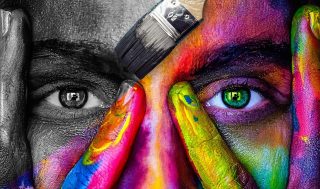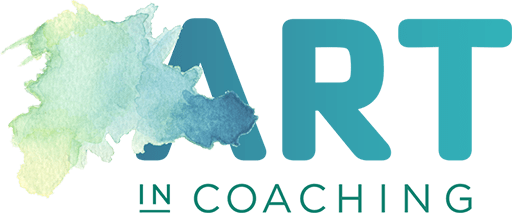In my blog ‘Is trauma present? The survival self in coaching’ I explored why it is important to be able to recognise when the survival self* is present in the coaching space. Explaining that coaching only works when we are providing a safe, supportive and appropriate space to enable clients, and ourselves, to bring our healthy selves* to coaching.
In this next blog in the series focusing on trauma and art based coaching, I want to talk about safety in art based coaching. When we create safe spaces it provides greater opportunities for the healthy self to be present.
Through the making of art and using the language of art we offer clients a safe way for self expression and connection to complex and sometimes difficult experiences. However, there are also aspects of the art based approach that could create an unsafe space if not approached with care and sensitivity.
The safe language of art
 Using art in coaching is a playful, joyful and liberating place for clients to work. It is also a safe and supportive space as the language of art allows clients to connect and work with that which had been seemingly impossible to articulate and understand. It enables clients to make sense of and take forward the issue.
Using art in coaching is a playful, joyful and liberating place for clients to work. It is also a safe and supportive space as the language of art allows clients to connect and work with that which had been seemingly impossible to articulate and understand. It enables clients to make sense of and take forward the issue.
When clients create their images they externalise the felt experience giving it tangibility as well as being able to be hold it safely outside of themselves within the image itself.
Then when exploring their image, the visual language, the language of colour, form, texture and line removes any pressure to analyse, label or explain. This enhances the safe coaching space and leads to the breakthroughs that art brings.
The art based coaching space brings a shared creative space that builds trust quickly where clients may feel safe enough to share their trauma stories with us. This may also happen more frequently as the art based approach offers greater opportunity to explore more complex areas and connect deeply.
It is important, however, that art is used within the context of the coaching contract and does not stray into therapy and working with trauma. It is important that we understand our boundaries and use supervision to support us in being alert to and maintaining those boundaries.
Our role when clients share their trauma stories
When a client does sufficiently trust the coaching space and feels safe enough to share their trauma experiences with us, we need to be able to be with it and hear it. We shouldn’t close it off but rather bear witness to and value their trauma story. Once shared, it is not our role to work with their trauma but rather to help them think through what they want to do with that experience and who they could engage with to work with it.
However, there may be times, when working with our clients with art that the process inadvertently connects our client with their trauma story, bringing the past into the present. We need to be alert to the fact that art connects our clients to implicit hidden memories and asking someone to make art could act as a trauma trigger.
Art and connecting to implicit memories
 When coaching with art we are using the language of the implicit. Trauma experiences are shut away from cognition but can be accessed through the creation of images and self-expression through art. This may mean that unsettling memories could emerge; memories that the client does not want to go to, may not be ready to connect with nor does not want to share. This may catch them by surprise and the coaching space can suddenly become an unsafe space. They may feel very exposed and vulnerable. Here the contracting process is crucial.
When coaching with art we are using the language of the implicit. Trauma experiences are shut away from cognition but can be accessed through the creation of images and self-expression through art. This may mean that unsettling memories could emerge; memories that the client does not want to go to, may not be ready to connect with nor does not want to share. This may catch them by surprise and the coaching space can suddenly become an unsafe space. They may feel very exposed and vulnerable. Here the contracting process is crucial.
Contracting is crucial
When contracting to use art in our coaching it is important that we explain the process fully, that our client understands what is involved and the deep connections to mind, body and emotions that can occur through the art and that they know they can stop at any time. The client needs to know and trust that they are fully in control.
Art as a trauma trigger
When introducing art clients will often be slightly anxious about the approach as they doubt their creativity and fear being judged or made to look silly. This is usually overcome once clients experience the process, and we also know that shift can happen when clients are taken out of their comfort zones and stretched a little. However, there may be times when more is going on and we need to be alert to the possibility that the thought of making art could act as a trigger.
Our perceptions of our ability to be creative are shaped in early years and where clients bring early years trauma into the coaching space, art and making art may be part of that early year’s trauma and act as a trigger. This would be very rare but where a client is clearly very uncomfortable about using art, or they approach it in a superficial way we should be sensitive to this and seek other approaches. Continuing with art in coaching here could be damaging and could also undermine the coaching relationship and the coaching.
Closing thoughts
Being trauma aware when coaching enables us to be confident in using art based approaches rather than limiting what we do. It enables us to be alert to behaviours and responses so we can respond appropriately, creating and maintaining safe spaces, working within the boundaries of the coaching contract and giving our clients the opportunity to access to their healthy resources – ultimately getting the best from their art based coaching experiences.

* Professor Franz Ruppert came up with a way of conceptualising trauma through the metaphor of split psyche. Ruppert says that as a person experiences trauma their psyche starts to split into three – the trauma self, the survival self and the healthy self.
Join the masterclass… If you would like to explore further why not join Julia Vaughn Smith and me on the next Trauma and Art Based Coaching online masterclass
References:
Coaching and Trauma by Julia Vaughan Smith, Open University Press 2019
Trauma and Expressive Arts Therapy by Cathy Malchiodi, The Guildford press 2020
Previous blogs in the Trauma and Art Based Coaching series:
Is trauma present? The survival self in coaching


One comment on “Safety, trauma and art in coaching”